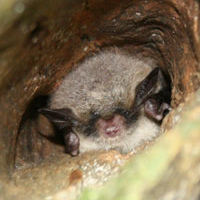Northern myotis
Scientific name: Myotis septentrionalis

Cover photo credit: Ann Froschauer USFWS
Status
Endangered
“Endangered” means the species lives in the wild in Ontario but is facing imminent extinction or extirpation.
Date added to the Species at Risk in Ontario List
January 24, 2013
Read the Assessment Report
What it looks like
Northern long-eared bats have dull yellow-brown fur with pale grey bellies. They are typically about eight centimetres long, with a wingspan of about 25 centimetres. Northern long-eared bats usually weigh between six and nine grams – a little more than a Canadian loonie or toonie.
As their name suggests, they have long (rounded) ears. Northern long-earned bats look similar to the more common little brown bats. They can be distinguished by the fleshy projection that covers the entrance to the ear, which is long and thin, with a pointed tip.
Female northern long-eared bats usually give birth to one young, which is able to fly and obtain its own food when just a month old.
Where it lives
Northern long-eared bats are associated with boreal forests, choosing to roost under loose bark and in the cavities of trees.
These bats hibernate from October or November to March or April, most often in caves or abandoned mines.
Where it’s been found in Ontario
The northern long-eared bat is found throughout forested areas in southern Ontario, to the north shore of Lake Superior and occasionally as far north as Moosonee, and west to Lake Nipigon.
This bat is found in all Canadian provinces as well as the Yukon and Northwest Territories.
What threatens it
Northern long-eared bats are threatened by a disease known as white nose syndrome, caused by a fungus which is believed to have been inadvertently brought from Europe to North America.
The fungus grows in humid cold environments, such as the caves and mines where Northern long-eared bats hibernate. The syndrome affects bats by disrupting their hibernation cycle, so that they use up body fat supplies before the spring when they can once again find food sources.
It is also thought that the fungus affects the wing membrane, which helps to maintain water balance in bats. Because of this, thirst may wake bats up from hibernation, which may be why those infected with white nose syndrome can be seen flying outside caves and mines during the winter.
In Ontario, bat populations dropped by more than 90 per cent in eight hibernation sites with more than two years’ exposure to white nose syndrome.
Bats at more than three quarters of Ontario’s hibernation sites are at high risk of disappearing due to white nose syndrome. Mass die-offs mean that there are no individuals left to reproduce.
Action we are taking
Endangered Species and their general habitat are automatically protected
Recovery strategy
A recovery strategy advises the ministry on ways to ensure healthy numbers of the species return to Ontario.
Read the executive summary and the full document (December 5, 2019).
Government response statement
A government response statement outlines the actions the government intends to take or support to help recover the species.
Read the government response statement (September 8, 2020)
Habitat protection
General Habitat Protection - January 24, 2013
What you can do
Report a sighting
- the Ministry of Natural Resources and Forestry tracks species at risk such as the Northern long-eared bat. Report a sighting of an endangered animal or plant to the Natural Heritage Information Centre. Photographs with specific locations or mapping coordinates are always helpful.
- report any unusual bat behaviour or deaths to the Canadian Cooperative Wildlife Health Centre at
1-866-673-4781 or the Natural Resources Information Support Centre at1-800-667-1940 .
Volunteer
Volunteer with your local nature club or provincial park to participate in surveys or stewardship work focused on species at risk.
Be a good steward
- private land owners have a very important role to play in species recovery; if you find Northern long-eared bat on your land, you may be eligible for stewardship programs that support the protection and recovery of species at risk and their habitats
- consider building a bat box for your property; learn more about how to build one and where to set it up:
www.batcon.org/index.php/get-involved/install-a-bat-house.html - don’t enter non-commercial caves and abandoned mines where bats may be present; avoid visiting caves and abandoned mines where white nose syndrome has been identified
Report illegal activity
Report any illegal activity related to plants and wildlife to
Quick facts
- one bat can consume hundreds of flying insects each night during the summer; Northern long-eared bats help control populations of potentially harmful insects
- Northern long-eared bats locate food by using echolocation; they send out signals and when the echo of that signal bounces back, they can identify where objects are located
- while most Ontario bats catch their dinner in mid-air, northern long-eared bats have also been observed flying down and picking insects off tree leaves, grasses and the ground